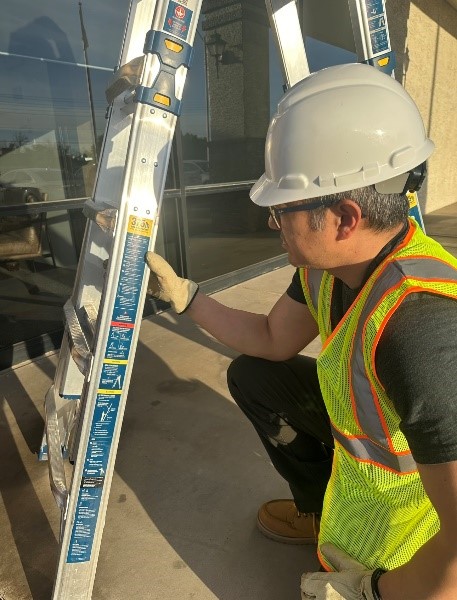Ladder Safety – How to inspect ladders?
Ladders are a common tool in many workplaces, but they can also be one of the most dangerous if not properly inspected and maintained. According to the Consumer Product Safety Commission (CPSC), there are approximately 300 ladder-related fatalities, and 165,000 emergency room visits due to ladder injuries each year in the United States.
The Occupational Safety and Health Administration (OSHA) has specific guidelines for ladder safety, including regular inspections. Here are some tips on how to properly inspect ladders to ensure they are safe to use:
- Start with a visual inspection: The first step in inspecting a ladder is to give it a visual examination. Look for any obvious signs of damage or wear, such as cracks, dents, or bent rungs. Check for loose or missing parts, and make sure all the feet and caps are intact.
- Check the label: Every ladder should have a label containing weight capacity, manufacturer, and model number information. Check the label to make sure it is legible and matches the ladder you are inspecting.
- Check the rungs: The ladder rungs are the part you step on, so they are one of the most important parts to inspect. Check each rung to make sure it is securely attached to the ladder and is not loose or wobbly. Look for any signs of damage, such as cracks or rust.
- Check the rails: The ladder rails are the sides you hold onto while climbing. Check each rail to make sure it is straight and not bent or warped. Look for any signs of damage, such as cracks or splits.
- Check the locks and hinges: If the ladder has locks or hinges, such as a folding ladder, check them to make sure they are functioning properly. Make sure they lock securely in place and do not wobble or move.
- Check the feet: The feet of the ladder are the parts that touch the ground, and they are critical for stability. Check each foot to make sure it is intact and not missing any parts. Look for signs of wear or damage, such as cracks or splits.
- Check the angle: The angle of the ladder is also important for safety. A ladder that is too steep or too shallow can be unstable and dangerous. Check the angle of the ladder to make sure it is within the recommended range (usually 75 to 78 degrees).
- Check the overall condition: Finally, step back and look at the ladder as a whole. Does it look sturdy and well-maintained, or does it look old and worn out? If you have any doubts about the safety of the ladder, do not use it.
In addition to these inspection tips, OSHA also recommends that ladders be inspected regularly, especially if they are used frequently or subjected to heavy use. Inspections should also be conducted after any incident that could damage the ladder, such as a fall or impact.
By following these guidelines for ladder inspection, you can help ensure that the ladders in your workplace are safe to use and avoid potential accidents and injuries. Remember that ladder safety is everyone’s responsibility, and taking the time to properly inspect and maintain ladders can help keep everyone safe on the job.
